Artículo de investigación research report
http://dx.doi.org/l0.14482/zp.33.371.33
Reliability and Validity of Scale of Studies of the Perception of Internet Use*
Fiabilidad y validez de la escala de estudios de la percepción del uso de Internet
José marcos bustos aguayo
Universidad Nacional Autónoma de México Orcid: https://orcid.org/00 00-0003-3423-596X Email: marcos.bustos@unam.mx
Margarita Juárez Nájera
Universidad Autónoma Metropolitana, México Orcid: https://orcid.org/0000-0002-7447-8213 Email:mjn@azc.uam.mx
Cruz García Lirios
Universidad Autónoma del Estado de México
Orcid: http://orcid.org/0000-0003-9364-6796
Email: cgarcial213@profesor.uaemex.mx
Eyder bolivar mojica
Universidad Católica Luis Amigó, Colombia
Orcid: https://orcid.org/0000-0002-4144-0921
Email: eyder.bolivarmo@amigo.edu.co
Celia Yaneth Quiroz Campas
Instituto Tecnológico de Sonora, México
Orcid: https://orcid.org/0000-0002-6068-1552
Email: cjquiroz@itson.edu.mx
* Artículo derivado del proyecto: "Gobernanza de las Tecnologías de Información y Comunicación" financiado por la Red Académica Transdiscilinar, número de registro: ATN-HV-2019-001
Como citar este artículo:
Bustos Aguayo, J., Juárez Nájera, M., García Lirios, C., Bolivar Mojica, E. & Quiroz Campas, C. (2020). Reliability and validity of scale of studies of the perception of Internet use. Zona Próxima, 33, 27-41.
Recibido: 7 de enero de 2019
Aprobado: 19 de octubre de 2019
Abstract
The objective of this work was to establish the reliability and validity of an instrument that measured the perception of Internet use. A non-experimental work was carried out with a non-probabilistic selection of 340 students from a public university in central Mexico. The results show a total percentage of variance explained by two perceptual dimensions that allude to the search and selection of information, although the type of design limited the results to the research scenario, suggesting the inclusion of factors related to the beliefs of use of Internet and the provisions as determinants of intentions and the use of digital networks.
Keywords: Governance, Internet, networks, technologies, devices, selectivity.
Resumen
El objetivo de este trabajo fue establecer la confiabilidad y validez de un instrumento que midiera la percepción del uso de Internet. Se realizó un trabajo no experimental con una selección no pro-babilística de 340 estudiantes de una universidad pública en el centro de México. Los resultados muestran un porcentaje total de varianza explicado por dos dimensiones perceptivas que aluden a la búsqueda y selección de información, aunque el tipo de diseño limitó los resultados al escenario de investigación, lo que sugiere la inclusión de factores relacionados con las creencias de uso de Internet y las disposiciones como determinantes de intenciones y el uso de redes digitales.
Palabras clave: gobierno, Internet, redes, tecnologías, dispositivos, selectividad.
Since its inception, the Internet has been an hegemonic factor in academic and professional training, although its use as a tool for information processing has not even been explored. The objective of this paper is to establish the reliability and validity of an instrument that measures the perception of internet use, considering a review of the literature that goes from 1996 to 2019, using the keywords of "technology", "management" and Internet in repositories of Latin America; Dialnet, Latindex, Redalyc and Scielo (see Table 1).
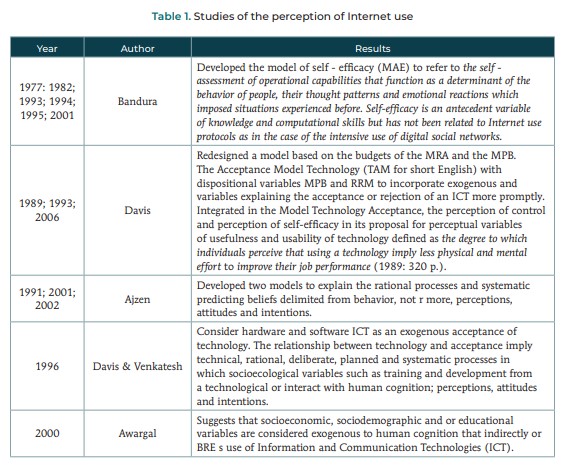
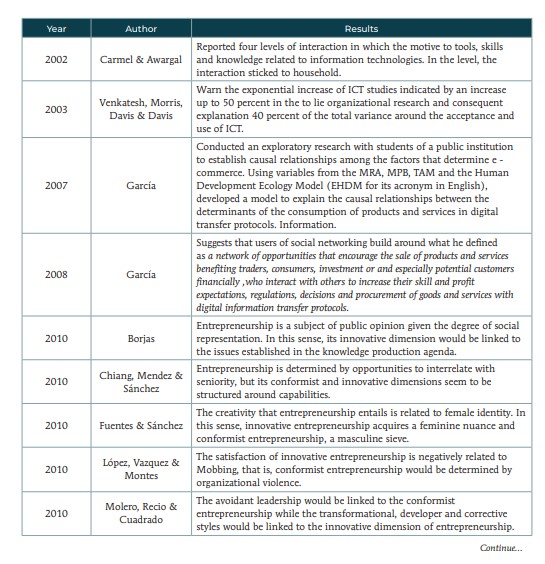
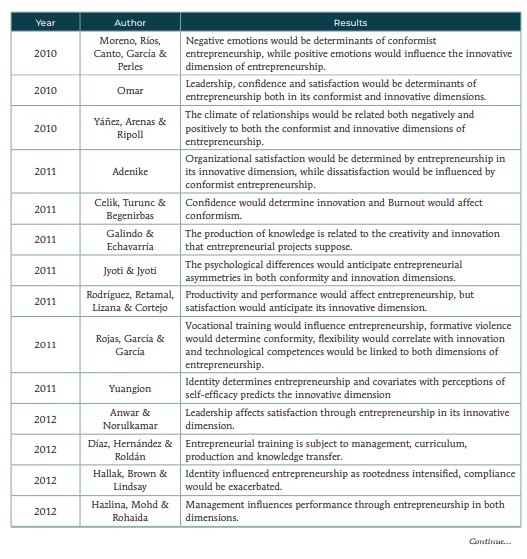
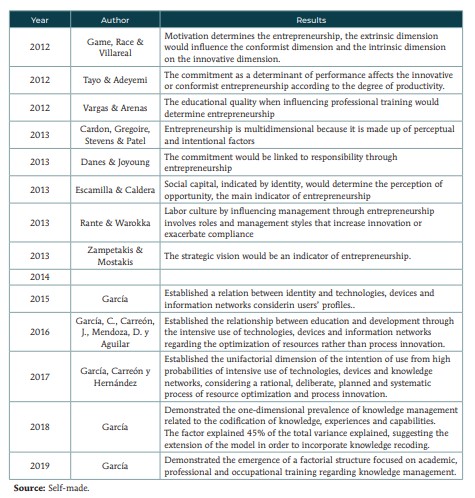
It is possible to appreciate that: 1) the studies focus on predicting the use of the Internet; 2) cognitive factors are determinants of the fusion between technology and capabilities; 3) the perception of Internet use is essential for knowledge management; 4) the production and transference of knowledge is carried out in organizations that adopted information technologies, devices and networks (García, 2007; 2008).
In the case of the perception of Internet use, it has focused on the capacity, usefulnes and ease of use as the determinants of the dispositions and intentions of Internet use, although the perceptions of risk are the determinants of decision making in transactions and purchase of products or the request for digital services (Garcia, 2011a; 2011b; 2011c; 2011d; 2011e).
Precisely, in the case of the perception of usefulness and the perception of risks, these have demonstrated their predictive power with respect to the intentions of use and consumption of digital services, but in the case of the perceptual dimensions they have not diversified in accordance to technological advances (García, 2012; 2013; 2018).
The perceptual dimensions in relation to capabilities and technological advances would explain the relationship between risks and utility with respect to the efficient use of the Internet (Garcia, Carreon, Hernandez, Montero & Bustos, 2013).
The perception of risks has been a determinant of favorable attitudes towards the use of the Internet, as would be the case of identity theft and pathologies such as harassment (Garcia, Carreon, Hernandez, Montero & Bustos, 2012).
In the case of perceived usefulness, expectations have been addressed from instruments that explore individual features such as the use of digital technologies and networks that explain information processing (Garcia, Carreon, Hernandez, Bustos, Morales & Lemon, 2013).
Regarding the perceived capacity in the use of Internet has been a preponderant variable in the study of academic and professional training, as well as transfer and training programs (Garcia, Carreon, Hernandez, Bustos, Bautista, Mendez & Morales, 2013).
Well, the three perceptual variables such as risk and usefulness have been diversified in their dimensions, but only in terms of digital economic protocols such as electronic banking, bypassing aspects of educational and academic order aimed at job placement (Villegas, García & Hernández, 2018).
In summary, studies of the perception of Internet use have focused on the risks and usefulness of the use of technologies, devices and information networks, circumventing the powers for research such as the search and choice of Information for processing.
Likewise, knowledge management and production are related to the search and information selection skills, since both involve the codification of knowledge, experiences and capacities aimed at optimizing resources and innovating processes.
Based on the impact factors of journals and author indexes, the search and selection of information suggests the optimization of common resources would be the case of the research experiences that are transferred between the interested parties.
However, in the case of process innovation, the search and selection of information by reducing the risks of creating and implementing a proposal, increase new forms of management.
Method
Are there significant differences between the theoretical dimensions of the perception of Internet use with respect to the relationships between factors and indicators to be observed?
Null hypothesis: There will be differences between the theoretical dimensions of the perception of Internet use reviewed in the literature with respect to the relationships between factors and indicators to be observed.
Alternate hypothesis: There will be significant differences between the theoretical factors and the empirical relationships between their observed indicators.
Participants
A non-experimental study was carried out with a non-probabilistic selection of 340 students from a public university in central Mexico (see Table 2).

Instrument
The Internet Use Perception Scale was used, which has its predecessor in the Ease of Use Scale proposed by Davis (1987) and the Bandura Self-Efficiency Scale (2001). Both scales suggest that the intensive use of technologies, devices and information networks is due to the continuous, gradual and staggered learning of these resources in terms of optimization and innovative transformation.
In other words, the optimization of information technology resources, as well as the innovation of teaching-learning processes suggests a continuous processing of information, indicated by the search for this technology and its selection based on universally built criteria on the internet.
Despite the restrictions on access to specialized and updated information, resource optimization and process innovation is possible based on the information available for evaluation. This is because the information flows regularly, considering open access policies, the dissemination of institutional or private collections, as well as technologies, repositories or applications dedicated to the dissemination of science and technology.
This is how the Internet Use Perception Scale covers both dimensions when trying to weigh management learning and knowledge production in its information processing phase, mainly focused on the search and selection of findings or data.
The Internet Perception and Use Scale (IPU-14) was built, which included dimensions related to information processing such as search and data selection. All the items are answered with one of five options: 0 = "not likely" until 5 = "quite probable" (see Table 3).
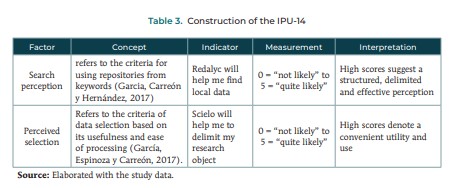
Process
The surveys were carried out in the public university facilities, provided with a written guarantee of confidentiality, anonymity and non-impact of the results on the academic status. The information was processed in IBM-SPSS-AMOS version 25.0 considering the normality, reliability and validity from exploratory factor analysis of principal axes with promax rotation.
The criteria for observing the normal distribution were a threshold between 0 and -1 in the case of kurtosis; but in the case of multivariable kurtosis, a value greater than 25 units of the Mardia parameter is the indispensable minimum. In the case of the most optimal internal consistency, the alpha coefficient had to reach a value greater than 0.60 and less than 0.90; but in terms of validity this threshold was from 0.30; being in the case of correlations and beta weights greater than 0.60
Results
Table 4 shows the statistical properties of the instrument in which it is possible to appreciate that they comply with the requirement of consistency, as well as the convergence of factors in two constructs.
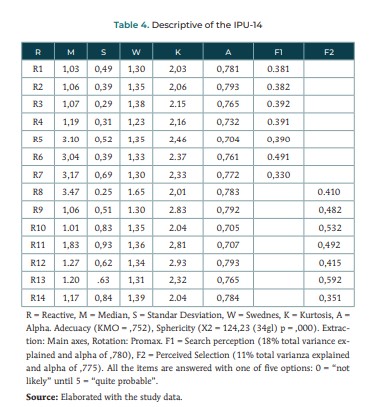
However, both factors only explain 29% of the total variance, suggesting the inclusion of other factors that the literature identifies as computational self-efficacy and compatibility. The adjustment and residual parameters fX2 = 456,34 (34gl) p = ,008; GFI = ,990; CFI = ,995; RMSEA = ,009j suggest the null hypothesis of the null hypothesis relative to the adjustment of the theoretical dimensions of the perception of Internet use with respect to its observed factors and inducers.
Discussion
The contribution of the present work consists in establishing the reliability and validity of an instrument that measures the perception of Internet use, but the type of non-experimental study, the type of non-probabilistic sample selection and the type of exploratory analysis limited the results to the research scenario, suggesting the inclusion of compatibility and self-efficacy.
The percentage of variance explained suggests the inclusion of both factors, although the internal consistency seems to indicate the exclusion of items that will reduce both factors.
García (2018) warns that the processing of information to be determined by the management of knowledge enhances the factor of the search for information that in the present work has been linked to the selection of the same and both explain the perceived use of technology in what to repositories refers.
García, Rivera & Aguilar (2018) demonstrated the influence of digital networks in the rescue of those trapped by the earthquake in Mexico City, evidencing the importance of electronic networks that this study has highlighted as a search and selection tool associated with the knowledge of a subject.
García, Martínez & Rivera (2018) demonstrated the link between digitalized knowledge networks and labor flexibility in terms of location, scope and usefulness, but as far as this research is concerned, knowledge networks would be explained by the search and selectivity of information.
However, the IPU-14 should be contrasted in other scenarios and samples in order to give it validity and be able to associate it with other scales that the literature refers as adoption models of technology, electronic commerce and risk in transactions.
In relation to the instruments used in the literature consulted and with respect to the reported reliability and validity where one-dimensional variables focused on the use of the Internet and stand out as an instrument for learning skills and control over resource optimization and innovation of processes, in the present work it has been shown that two indicators prevail that explained 29% of the total variance explained, suggesting the extension of the work towards other indicators such as the compatibility between the meanings of technology, devices and information networks regarding their Intensive use for processing, management and production of knowledge.
Conclusion
The objective of this paper has been to establish the reliability and validity of an instrument that measures the perception of Internet use, but the IPU-14 shows a consistency that is insufficient, as well as a validity that would include a third factor related to the use of the Internet efficacy, although the type of study, sampling and analysis limit the results to the context of the investigation, the contrast of the instrument in other samples will be relevant.
References
Ballesteros, R., Gil, M., Gómez, S. & Gil, B. (2010). Psychometric properties of an evaluation of addiction to cybersex. Psicothema, 22, 1048-1063.
Byrne, B. (2011). Structural equation modeling with M-plus. New York: Routledge T & F
Chuo, Y., Tsai, C., Lan, Y. & Tsai, C. (2011). The effect of organizational support, self efficacy and computer anxiety on the usage intention of e-learning system in the hospital. African Journal of Business Management, 5, 5518-5523.
Garcia, C. (2007). A theory of mobile consumer. Today Society, 13, 9-24.
Garcia, C. (2008). The digital divide of future generations. Entelequia, 8, 61-72.
Garcia, C. (2011). Structure of attitudes towards e - commerce. Contributions to Economics, 14, 1-10.
Garcia, C. (2011a). Structure of the perception of Internet use efficiency. Contributions to Social Sciences. 16, 12-24
Garcia, C. (2011b). Structure attitudes towards consumer electronics. Contributions to the economy. 17, 1-12
Garcia, C. (2011c). Electronic structure of consumption. Journal of Political Psychology. 26, 74-83
Garcia, C. (2011d). hybrid structure attitude toward using internet from sociodemographic variables. Contributions to Social Sciences. 16, 1-12
Garcia, C. (2011e). Reflective structure of the utility of electronic commerce. Poiesis . 22, 1-14
Garcia, C. (2012). Hybrid structure of socio - demographic determinants of consumer electronics. Gepu, 3, 43-53.
García, C. (2012). reflective structure of the perception of Internet use efficiency. Nomadic, Special Issue Latin America.
Garcia, C. (2013). Usefulness and attitude toward risk in social networks. Folios, 29, 91-103.
García, C. (2014). Redes de identidad y subjetividad en torno al establecimiento de agenda. Revista Iberoamericana de Ciencias Sociales, 1 (1), 1-9
García, C. (2015). Contrast of a model of intent to use of internet. Psychology 19 (1), 1-17
García, C. (2018). Reliability and validity of an instrument that measures knowledge management in a public university in central Mexico. Tlatemoani, 27, 285-305
García, C. (2019). Exploratory factor structure of professional training expectations. Hitos, 25 (72), 252-270
Garcia, C. Carreon, J., Hernandez, J., Bustos, J., Bautista, M. Mendez, A. & Morales, M. (2013). Reliability and validity of a measuring instrument internet search. Journal of Psychology at the University of Antioquia 5 (1), 27-34.
Garcia, C. Carreon, J., Hernandez, J., Bustos, J., Morales, M. & Lemon, G. (2013). Utilitarian and efficient Internet use. Management Vision, 12 (2), 281-292.
Garcia, C. Carreon, J., Hernandez, J., Montero, M. & Bustos, J. (2012). Reliability and validity an instrument that measures the perception of efficiency of use of Internet in a public of Mexico, Federal District. Invurnus, 7 (2), 3-11.
Garcia, C. Carreon, J., Hernandez, J., Montero, M. & Bustos, J. (2013). The structure of the co n most e. Teaching and Research in Psychology, 18 (2), 389-402.
García, C., Carreón J. y Hernández, J. (2017). Test of a model of the perceptual determinants of the intent to use the Internet in users of a public library in Mexico City. Interconectando Saberes, 2 (3), 39-56
García, C., Carreón, J., Mendoza, D. y Aguilar, J. A. (2016). Education and internet or local development. 14 (94) 42-94 http://dx.doi.org/10.15198/seeci.2015.36.42-94
García, C., Espinoza, F. y Carreón, J. (2017). Model of intangible assests and capitals in organizations. International Journal of Research in Humanities and Social Studies, 5 (4), 1-12
García, C., Martínez, E. y Rivera, P. E. (2018). Labor flexibility in higher education. Inclusiones, 5, 51-59
García, C., Rivero, A. G. y Aguilar, J. A. (2018). Framework of digital networks around millennial values in the issues of 7s and 19s. Tlatemoani, 27, 70-91
Hee , D. & Mc Daniel, S. (2011). Using an extended Technology Acceptance Model in explo r ing antecedents to Adopt fantasy sports league websites. International Journal of Sport Marketing & Sponsorships, 17, 240-253.
Lopez, L. & Lopez, J. (2011). Models adoption of information technologies from the attitudinal paradigm. Notebooks EBAPE, 9, 176-196.
Nunez, D., Ochoa, E., Wallis, J., Fernandez, M. & Peace, G. (2013). Attitudes and habits partnered to two through the use of ICT in psychology students. Latin America Psychology, 25, 91-114.
Orantes, S. (2011). Feasibility model of technology acceptance in Mexican companies. An approach to the attitudes and perceptions of the users you're of information. Magazine Digital University, 12, 1-15.
Sandoval, R. & Saucedo, N. (2010). Stakeholders in social networks: the case of Hi5 and Facebook in Mexico. Education and Humanities, 4, 132-142.
Shrrof , R., Denenn , C. & Ng, E. (2011). Analysis of the Technology Acceptance Model in examining student's behavioral intention to use an e-portfolio system. Australasian Journal of Educational Technology, 27, 600-618.
Simsek, A. (2011). The relationships Between computer anxiety and computer self-efficacy. C ontempo-rary Educational Technology, 2, 177-187.
Source, A., Smith, J. & Gracia , E. (2010). Internet and social support: sociability online and psychosocial adjustment in the information society. Psychological Action, 7 9-15.
Teh , P., Chong, C., Yong, C. & Yew, S. (2010). Internet self-efficacy, computer self-efficacy, and cultural factors on knowledge sharing behavior. African Journal of Business Management, 4, 4086-4095.
Villegas, E., García, C. y Hernández, T. J. (2018). Establishment of the scientific and technology political for the incubation of innovations knowledge. Inclusions, 5, 19-26